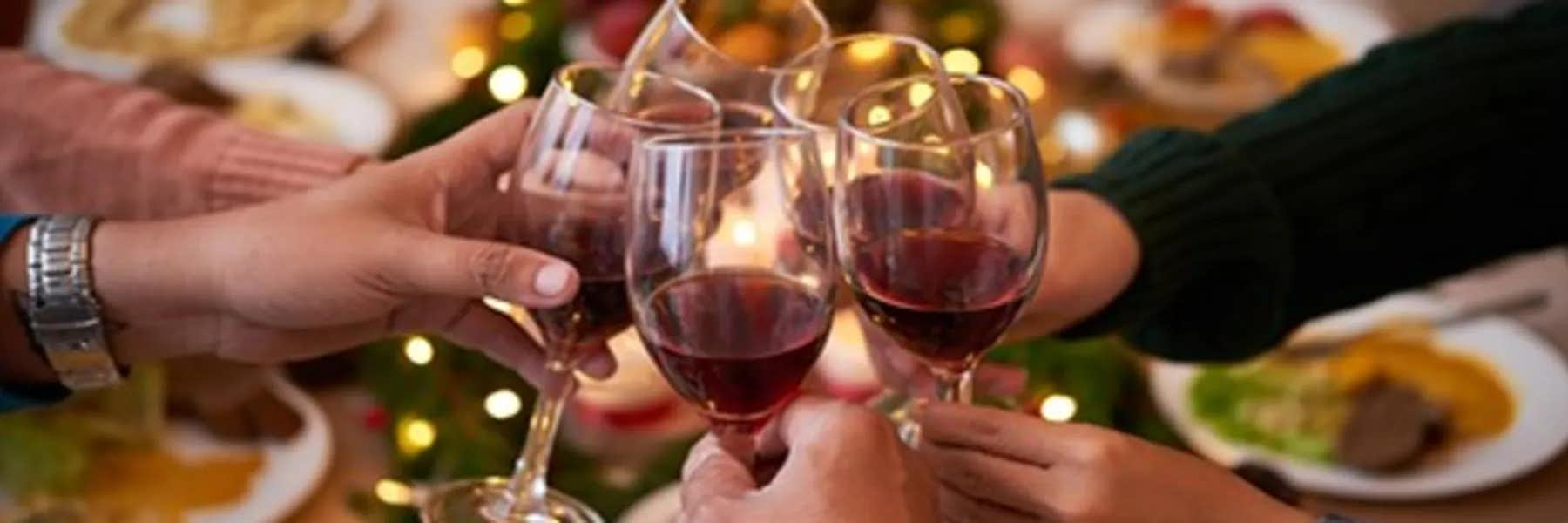Whether you’re living overseas or just traveling for a holiday season vacation, the world is full of opportunities to escape the usual Christmas routine.
U.S. expats around the world are celebrating in many different ways in their new homes. Here are 11 examples from across the globe—each offering their own unique flair of festivities.
Costa Rica—Tamale Making
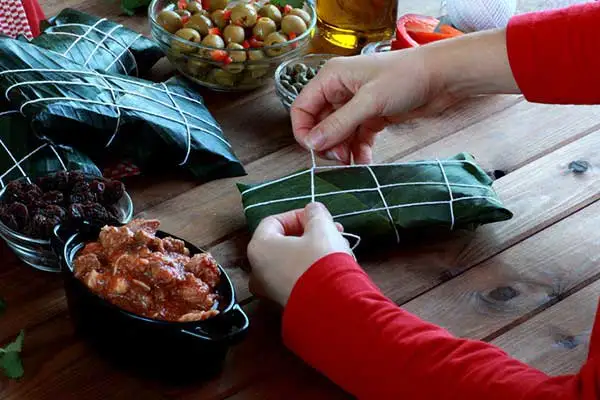
A classic Christmas holiday tradition in Costa Rica is tamale making—a family and multigenerational matter.
“Tamales are one of the most popular Christmas traditions in Costa Rica,” says Kathleen Evans, IL Coastal Costa Rica Correspondent. “Tamales are made from corn flour and are filled with a variety of different ingredients, such as potato puree, rice, vegetables, garlic and onions, and shredded pork or chicken or beef, all wrapped in banana leaves (not corn husks which you see in many other countries) and tied with string into squares and boiled. Two tamales tied together are called a piña.
“Women gather in the kitchen for a massive all-day project of tamale making in December and share (or sell) them throughout the month.
“Costa Rica’s Christmas celebration typically begins on Christmas Eve, or Noche Buena, when people visit family and friends for lively dinners of roast pork leg, tamales, pastries, and other desserts—we love our sweets, here. Rompope or eggnog, heavy with rum, is often served while family members exchange presents before midnight.”
Although officially in the northern hemisphere, December is considered "summer" in Costa Rica because the rainy season has ended, and the kids are out of school. That means immediately after Christmas the families in the cooler Central Valley flock to the beaches in Puntarenas and Guanacaste soaking up the sun and enjoying concerts on the beach through to New Years. Lights twinkle, Chinese lanterns float, fireworks explode, and it is a very magical time of year.
Colombia— Little Candles Night
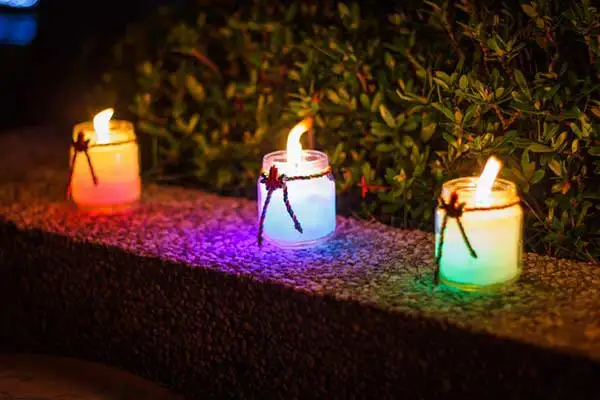
Christmas in Colombia is a celebration of lights, food, music, family and friends that lasts from early December until mid-January. Traditions and celebrations vary by region and city, but all are held with the idea of enjoying the season.
“One of the most interesting celebrations is Little Candles Night to commemorate the eve of the Immaculate Conception and the unofficial start of the Christmas season for the entire country,” says Nancy Kiernan, IL Colombia Correspondent. “The festival begins at sunset on December 7th and ends at sunrise on December 8th.
“Candles and paper lanterns line the windowsills, porches, and balconies of people´s homes as well as sidewalks, streets and parks in both rural areas and the big cities. Some neighborhoods close the streets to cars, so the people can walk in and amongst the various displays in front of people´s houses. It is not uncommon for residents to invite complete strangers into their homes to enjoy a drink, something to eat and listen to music.
“In Medellín, Christmas begins at midnight on November 30th with La Alborada, residents setting off fireworks that rival many New Year´s Eve displays in brightness, length and volume. This also marks the first lighting of Los Alumbrados (Christmas lights). The Medellín tradition is in its 51st year, and this year´s theme recognizes Colombia as the second most biodiverse country in the world. Eleven tons of metalized paper and 26 million LED lights are shaped into some of the thousands of species of birds, flora, and fauna that are indigenous to Colombia.”
From December 16th until Christmas Eve, many Colombians take part in novena. These are special times when family, friends, and neighbors come together to pray in the days leading up to Christmas. A different house hosts the meeting every night. As well as the prayers, people sing carols and eat lots of traditional Christmas food such as natilla (a firm milk custard), buñuelos (fried cheese fritters), and hojuelas (thin fried dough).
Ecuador— The Pase del Niño Parade
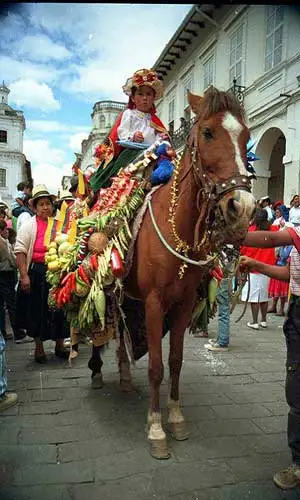
“The holidays are absolutely my favorite time of year in Cuenca, especially the Pase del Niño parade,” says Donna Stiteler, ILCuenca Correspondent.
“The Pase del Niño (Passing of the Child) starts with a Christmas Eve parade downtown but is actually a three-month-long activity, beginning the first Sunday after Advent and continuing to Carnival in early March.
“I’m lucky because my house sits on the parade route, so I’m treated almost every weekend to a line of girls dressed as angels riding on the backs of elaborately dressed horses right in front of my house.
“The costumes are homemade and proud fathers hoist their daughters onto the horses and parade with their entire family beaming. The Christian festival combines Catholic and indigenous traditions. It starts with an eight-hour parade downtown which includes floats and cars decorated with flowers making it an Ecuadorian answer to the San Francisco’s Rose parade.
“Hundreds of children watch the parade dressed in homemade costumes while watching bands, dancers, stilt walkers, street performers and all types of interpretations of biblical characters (imagine the Three Wise Men riding on Harley Davisons) stroll by while people roast pigs and chickens on street corners. The parade has approximately 50,000 participants, with about 200,000 people watching from sidewalks or balconies.
“Seeing families bond over this tradition and their commitment to their faith is an everyday reminder to me of what Christmas is all about.”
Belize—New Year’s Eve

“New Year’s Eve is a huge night in Belize,” says Laura Diffendal, IL Belize Correspondent. “There’s a party in every major town with fireworks and vast parties. Belize is a very festive country, and everyone gets behind the celebrations.
“In Placencia, the main party is in the Central Park area with many vendors, local food and drinks, and bars line the zone—a great place to sit at an open-air bar and people watch. After the party in the park, the crowd tends to move to the many beachfront bars and docks to settle in for the fireworks. Of course, the party doesn't end after the fireworks—the party goes on late into the night…or into the next morning!”
Mexico— Three Kings Day
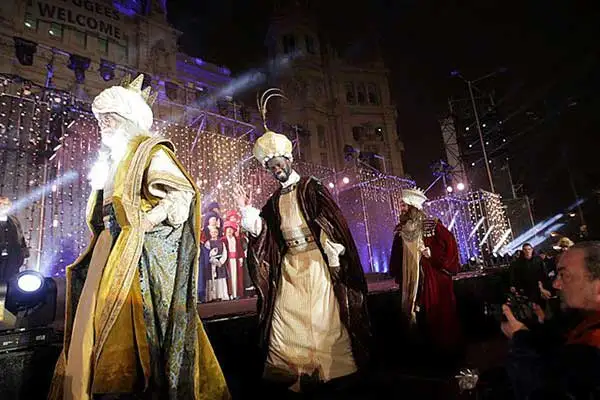
Celebrations usually take place on Christmas Eve in Mexico, with carols, a big meal, and maybe mass at midnight. However, a few days later is an even bigger day.
“Three Kings Day or El Dia de Reyes, is an important celebration in Mexico,” says Don Murray IL Riviera Maya Correspondent. “Recognized on January 6th, this is the day that many locals exchange gifts to celebrate the biblical story of three kings visiting baby Jesus and is the traditional day children receive Christmas gifts.
“Depending on local customs and family traditions, this may also be the day that Santa delivers gifts to small children.”
Panama—Burning of Effigies
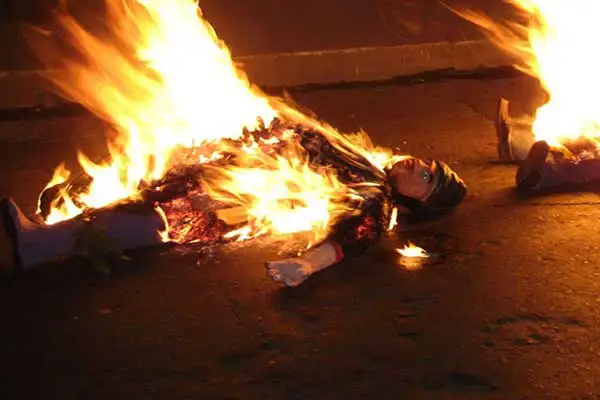
New Year’s is very interesting in Panama. In rural parts, people tend to burn effigies representing the old year—it’s their way of letting go of the past to embrace the new year. Effigies are often dressed as celebrities or public figures.
“On January 1st, Panamanians do more than usher in the coming year,” says Jessica Ramesch, IL Panama Editor. “It’s also a time to purge the evils of the past. Tradition in rural parts is not to make New Year resolutions, but to let go of negativity with a symbolic act: the burning of effigies.
“The tradition has evolved from simple beginnings when the typical muñeco de año viejo or “old year doll” had a long beard, a cigarette in its mouth, and a bottle of rum in its hands. People would place placards in front of the “dolls” or dummies, on which they had written every bad thing that had happened during the year, from political events to rising food prices.
“Today dummies made by local families can have unremarkable faces...a few lines symbolizing eyes, nose, and mouth drawn on a balloon. But the ones sold by craftsmen bear the likeness of “naughty” celebrities or politicians and can cost $80 to $300.
“These days you’ll see the best ones displayed along the Pan-American Highway thanks to local competitions in which there are sometimes cash prizes ($300-$600) for the most creative. The dolls represent the past year and its events, especially any let-downs or worries. For the religious, they represent Judas and so many Panamanians call the dolls “Judases.”
“A Judas can be made of whatever materials are on hand...coconuts, newspaper, leaves, old clothes, toilet paper, papier mâché, even gypsum, but the most important “ingredients” are the bombitas or small fireworks used to fill up the body.
“With some gas or starter fluid (do not try this at home), the dolls are set on fire during the first minutes of January 1. Stand back!”
Ireland—Wren Boys
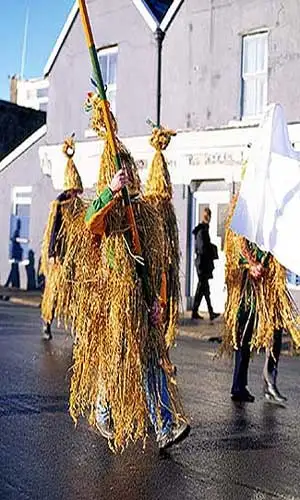
The Wren, is a tradition where men and boys paint their faces and dress up in old clothes and straw hats, traveling from house to house in rural areas playing music, singing, and dancing. It is celebrated in Ireland on St. Stephen’s Day, December 26th.
In previous times, the wren bird was hunted on this day and an effigy of which was carried about in a holly branch or cage.
The ritual is associated with the belief the bird betrayed Irish soldiers fighting enemies by beating their wings on their shields, making noise and waking the sleeping adversaries, and so saving the camp. It is also held responsible for betraying St. Stephen, the first Christian martyr, by flapping its wings to attract his chasers when he was hiding.
Most commonly practiced in the Southwest of Ireland in Cork and Kerry, today some towns host parades and stages with each Wren group performing before marching through the town holding pitch folks and playing music.
Portugal—Christmas Eve Celebrations
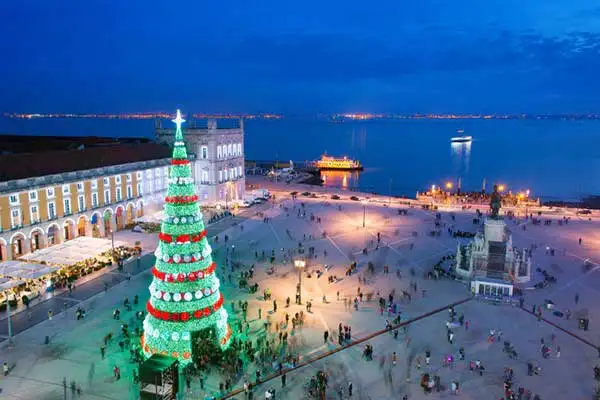
“As you might expect in a predominantly Roman Catholic country, Christmas still retains religious significance for much of the population,” says Tricia Pimental, IL Portugal Correspondent. “That’s not to say that Santa Claus, known here as Pai Natal, doesn’t make an appearance, though. And, as you also might expect, food and drink play an important role in the celebration of the holiday.
“On Christmas Eve families gather together for their consoada, a time to visit when traditionally bacalhau (dried, salted cod), is eaten together with boiled potatoes and cabbage.
“Often people attend church at midnight afterward. During the Missa do Galo (Mass of the Rooster), a representation of the Baby Jesus is finally placed in the presépio, or manger scene, every church has had adorning its interior or exterior for the past weeks.
“Many homes also have nativity scenes. Traditionally, prior to departing for the church, parents secretly put the Christ Child in place, delighting the returning children.
“In certain areas an enormous fire called the madeiro is built outside the church before the service begins, creating an inviting area to greet neighbors and stay warm.
“Another special occurrence on Christmas Eve is that the priest will baptize children free of charge—a nice gift for working parents.
“Favorite edibles at this time of the year include French toast known here as rabanadas, fried pastry dough dusted with confectioner’s sugar (filhós), and bolo rei (king cake), a kind of coffee cake with candied fruit. In the spirit of equality, there’s a bolo rainha (queen cake), minus the fruit but packed with nuts and raisins.”
Spain—Eating Grapes at Midnight
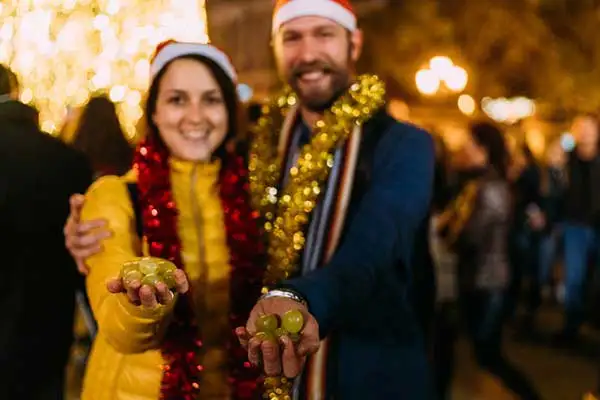
“In Spain, people usually celebrate on Christmas Eve, with a dinner late at night—traditionally something with fish or seafood,” says IL Spain Contributor. “This is followed by midnight mass (the Misa de Gallo) or alternatively just stay at dinner.
“Gift-giving is across two days. Children often get to open one gift on Christmas Eve and then the rest on Christmas Day—which is a day for being with family.
“There are no Boxing Day celebrations in Spain, but New Year’s Eve is party time…and eating grapes on the stroke of midnight.
“The tradition is to try to eat one grape for each stroke of midnight, and to finish all 12 grapes by the last stroke. If you do, you have good luck for the next year.”
Bali—Galungan
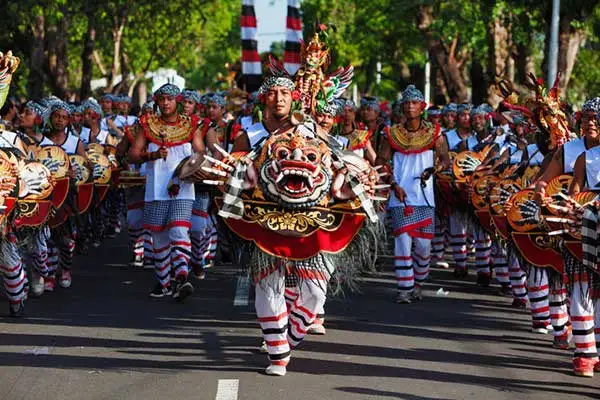
“For the Hindu Balinese, Galungan is observed twice a year based on the Pawukon 210-day calendar,” says Josephine Brierley, IL Bali Correspondent. “This year, Galungan will fall on December 26th, which means the whole island will be celebrating in their own very special way.
“Galungan is a Balinese Holiday which celebrates the victory of dharma over adharma, (the triumph of good over evil). As the legend goes, the Hindu God, Indra, battled with the Balinese king, Mayadenawa, to ensure the Balinese people were entitled to live in the Hindu way. It’s a big happy celebration where people eat good food, then dress up in their traditional clothing and visit temples and their families.
“The Balinese believe their ancestors return to visit earth on this day, and it’s a day of giving thanks and remembering those who have left. The families must be welcoming and hospitable to the spirits through prayers and offerings. The local temples are all decorated brightly and are crowded and colorful.
“The most obvious sign of Galungan is the many Penjor lining the streets. They are intricately decorated, tall bamboo poles adorned with offerings suspended from them, creating an arch across all roads as they stand outside each person’s home. The Penjor are created by the men of the family, who are extremely proud of their artwork.
“The celebration lasts for 10 days, during which families get together for fun. The end of the festival is marked by Kuningan, when the ancestral spirits leave.”
It’s a wonderful time to observe the Balinese celebrate their traditions and culture. If you’re in Bali, you’ll come across many ceremonies. Don’t be afraid to take photos but be considerate. Everyone should dress respectfully around the temples, with shoulders and the tops of their legs covered.
Thailand—New Years Eve Lanterns
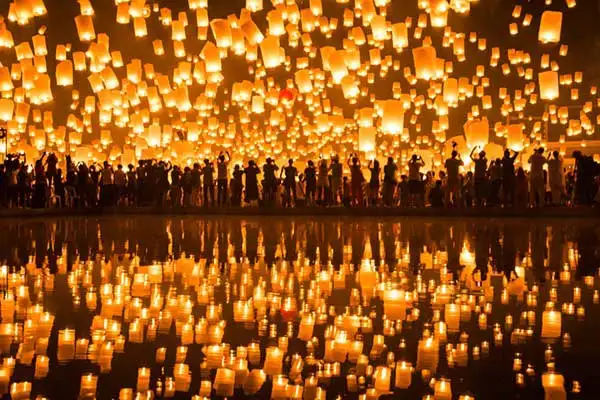
“Though Thailand’s New Year (Songkran) happens in April each year, Thai’s by nature love a party and have embraced our New Year’s Eve celebrations with all-out gusto,” says Michael Cullen, IL Thailand Correspondent.
“If in Bangkok, expect spectacular firework displays over the Chao Phraya River—best viewed from the cities renowned skyscraper rooftop bars and restaurants. This is repeated in all the regional cities and popular beach and island destinations across the Kingdom.
“But for a more cultural NYE, try Chiang Mai where thousands of people parade along the streets in the old town holding colorful paper lanterns with lit candles inside.
“At the stroke of midnight, everyone releases their lanterns into the air with much merriment and partying, and fireworks. Since moving to Thailand, I must say I love the unabashed fun Thai people add to these New Year’s Eve celebrations.”
Related Articles
The 11 Best Islands in the World to Retire On
